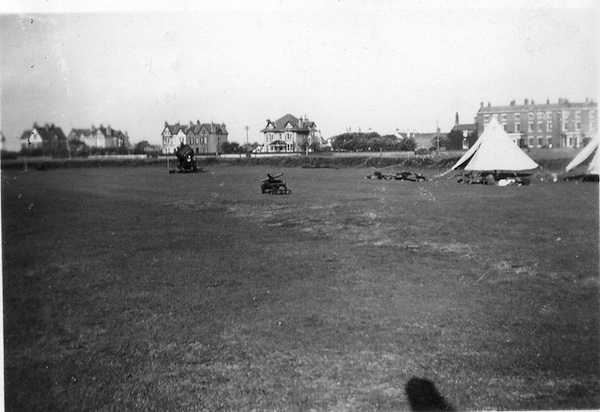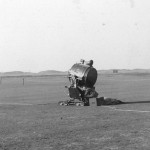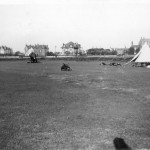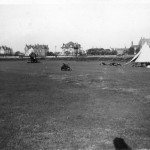click for larger version.
Many thanks to Chris Hankin who kindly sent me a batch of photos, the first of which I’m publishing as the subject of this weeks Friday Photo. Chris writes:
In 1939, whilst the local 149 regiment was still the TA before becoming the “Hoylake Horse” in the regular army, my father joined up and took part in a training camp on the Royal Liverpool Golf Course. These show the camp and some of the secret high tech equipment being tested in front of the Royal Hotel.
Note that building to the left of the old Royal Hotel …another house that’s disappeared over the years. I’ll publish the other couple of photos that Chris sent me next week. Here are a couple of other war kit photos (including duplicates) – as always, feel free to comment:





I remember the lady who lived in the house to the left of the Royal Hotel was a Miss Dorian (???) who had a big hairy dog that used to hang through the front gate and bark at passers by! She was a lovely lady. The house was demolished and replaced with a small apartment block in probably the late 1970s. I think it’s called Stanley House.
The house on the far left, now Invergarry Court, was the Watsons’ and they had a fabulous swimming pool in the dunes in the back garden. I think it was demolished in the early 1980s, perhaps a little earlier.
Hi All,
It is some seventy years since Merseyside suffered from the German Blitz.
This month (March) I have been looking for any records of the 10 neighbours of mine who were killed
31 March 1941. This was caused by a land-mine which fell on our road in Higher Tranmere.
(if you think that this is a different tack from my previous comments on Wood Street – you are wrong!)
I was surprised to find the following record held in the Liverpool Blitz fatalities :–
JONES, Civilian, HOWELL AP-EINION, Civilian War Dead. 4th May 1941. Age 40. Fire Salvage Officer. Husband of Hilda Myfanwy Jones, of 6 RUDD Street, Hoylake, Cheshire.
Died at Fire Salvage Station, Hatton Gardens, Liverpool
Reference : http://www.liverpoolatwar.co.uk/j.html
I believe that these records were not divulged during the war to limit German propagander. The Fire Service worked their socks off during the Blitz – particularly when they ran out of water to put out the fires.
No apologies for mentioning another unsung hero from Hoylake.
Ricky.
Good Welsh names.
I believe that areas of the city were marked off and you could not enter another area unless you were invited in by the local warden.
Welsh firemen were often held on the outskirts of the city waiting to be allowed in by the chief fire officer. One crew took shelter whilst waiting and after the all clear werer puzzled to find that their equipment had been borrowed and used by local firemen whilst they were in the shelter!
Bombs had a 1 in 10 failure rate, my father often heard the whistle of a bomb but no bang. There must be a lot of stuff out there still! He also ran towards a parachute mine thinking it was an airman in a parachute. He soon changed his mind when he realised what it was!
Parachute mines (land mines) were a chance invention, as marine mines aimed at the river came down on a parachute and would detonate automatically if they realised they had not landed in the water. This was to prevent the fusing and detection equipment being analysed by our scientists. The bonus was that a large explosive charge gently lowered on a parachute did not dig in to the ground and therefor blasted a much wider area.
This was also true for the V1 doodle bug, which glided in and exploded above ground compared to the V2 rocket which came down like a bullet and only caused localised damage.
The four dishes in one of the photographs look like microphones intended to detect bombers far away.
At Dover, they built a huge concrete reflector intended to detect bombers as they crossed the channel, but I don’t think it worked very well.